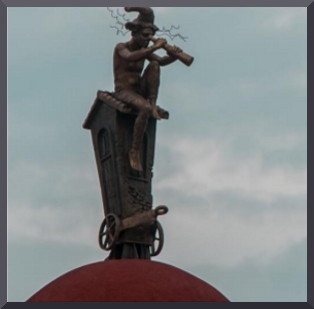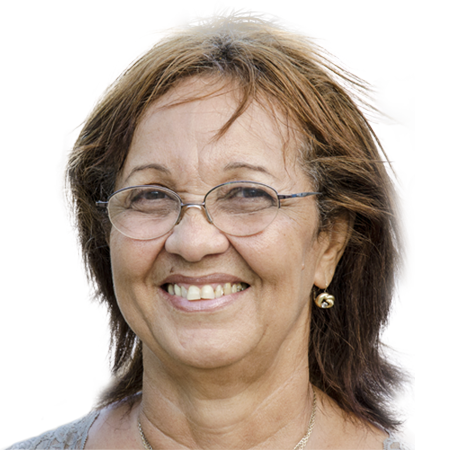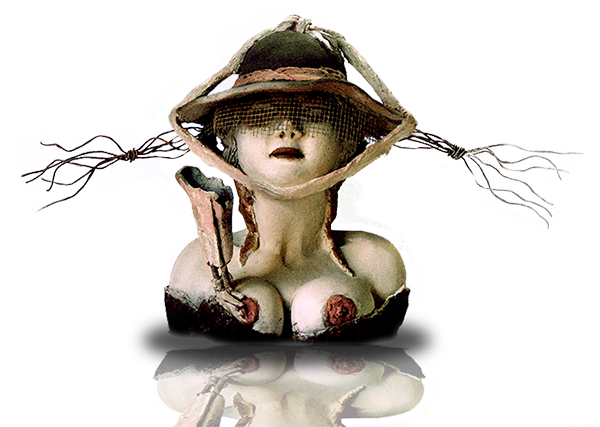

Snoop in sight
A little man looks at everything, he questions everything. With his house on a wagon he has traveled for half a millennium, and now, at last, he finds safe land. He goes on to tell us the legends of the voyage that begun in 1514, along the beach at Punta del Guincho, the horrors of the massacre of Indians in Caonao, and details of the rebellion that forced the Spaniards to seek refuge in the lands of cacique Camagüebax.
From the roof of clay, the snoop sees the people passing; to the streets connecting and separating each other in any point of Camaguey, as if five hundred years ago the peninsulars raised the churchs wildly, and the squares and buildings were built without taking into account the slightest knowledge of the rule and the cord.
From its height, he manages to interpret each square and understand the mystery of each church. Between one temple and another it is difficult to list the dwellings: all the red tiles come together to form almost a single roof, almost a single eave, which sometimes rises and others decline to die only a few centimeters after the facade.
It is the colonial city - with its houses of high strut, its hanging roofs and its walls of brick and mud- the one that shapes for the posterity the artist Martha Jimenez Perez, through this happy metaphor of transporting her villa up to the clouds. It is the history of the foundation of Puerto Principe placed in the dome of the Hotel Santa Maria, to remind the Camagueyans the lesson always applaudible of not to forgetting the past.
Walking through Republica or gliding along the Street of Movies, the Camagueyan or visitor are now forced to look up. Martha has named it Translation but, after the initiative of the Hotel Chain Encanto to place it as high as possible, people already speak of a lookout that is seen from far away.
A lookout -converted in bronze by the specialists of Caguayo S.A. In Santiago de Cuba- knows today where the tinajones hide, at what time the sun rises in the East, who attend Mass on Sundays and which bells are heard first every day in the morning.
"Camaguey needed a sculpture similar to its stories. I've been thinking about it for a while, and here's the result. I hope people remember it as the years go by. Translation is, of all my creations, the most related to the history of this city", says Martha while showing some paintings from her next personal exhibition.
After the last tour abroad, thanks to which she exhibited several pieces in Miami, Jimenez Perez prepares a new exhibition for the public. "At the end of November I will present some pictures at the UNEAC provincial headquarters. Always with the thematic lines followed during my career. I am interested in the problems of the common people, femininity and erotic dialogue between both sexes, and of course everything related to our status as islanders".
The work of Martha Jimenez transcends the frontiers of the community that received her art with urgency and necessary empathy. More than 300 exhibitions in more than 20 countries, and recognitions such as the Shanghai Biennial of Contemporary Art, China, or the Single Prize at the Fifth International Terracotta Biennial in Turkey, endorse the curriculum of who also holds the Distinction for National Culture.
"In Miami I could realize a dream. It is a series of nine unique samples, titled the lost wax. It is a very old technique. It includes the modeling in paste and its later lining with wax, which is armed under vacuum and filled with bronze. This allows you to work easily the details and give you more movement and volume", says the artist, who thanked the workshops of Art Foundry, in the State of Florida, for giving her that opportunity.
The work of her, UNESCO Prize for the Best Set of Works, for the four scenes of the Plaza del Carmen, locates she within the group of most important creators of the contemporary avant-garde in the visual arts.
In 2002, Martha produced a street vendor (Mata'o), a newspaper reader (Subirat), a couple of grooms and three black gossipers, thus bequeathing her "greatest passion and source of life", her world of attributes and symbols, her already recognized lyrical intimacy. All real and common characters, as similar to their models as the rest of the Camagueyans.
"Let's go to the gallery to show you some new things", she says. We leave the studio and enter almost covertly, because the visitors do not stop asking for the artist. But she is not addicted to flattery.
There the confections of mud or bronzes, the paintings, the engravings and the drawings are located in the exact place: above the brick floor of the former dwelling; in small stands; on the walls, supported by wooden slats; illuminated by a mixture of litmus lights, which trap you in a kind of spiritual rest.
Outside, in Plaza del Carmen, you can hear the drums of Rumbata and the choir of dozens of people, while the children run around Subirat.
-"There are several tourists watching", I say to Martha.
-Yes. They want to understand, but they can not.
By: Rafa Nuñez
OnCuba Magazine
November 4, 2014




